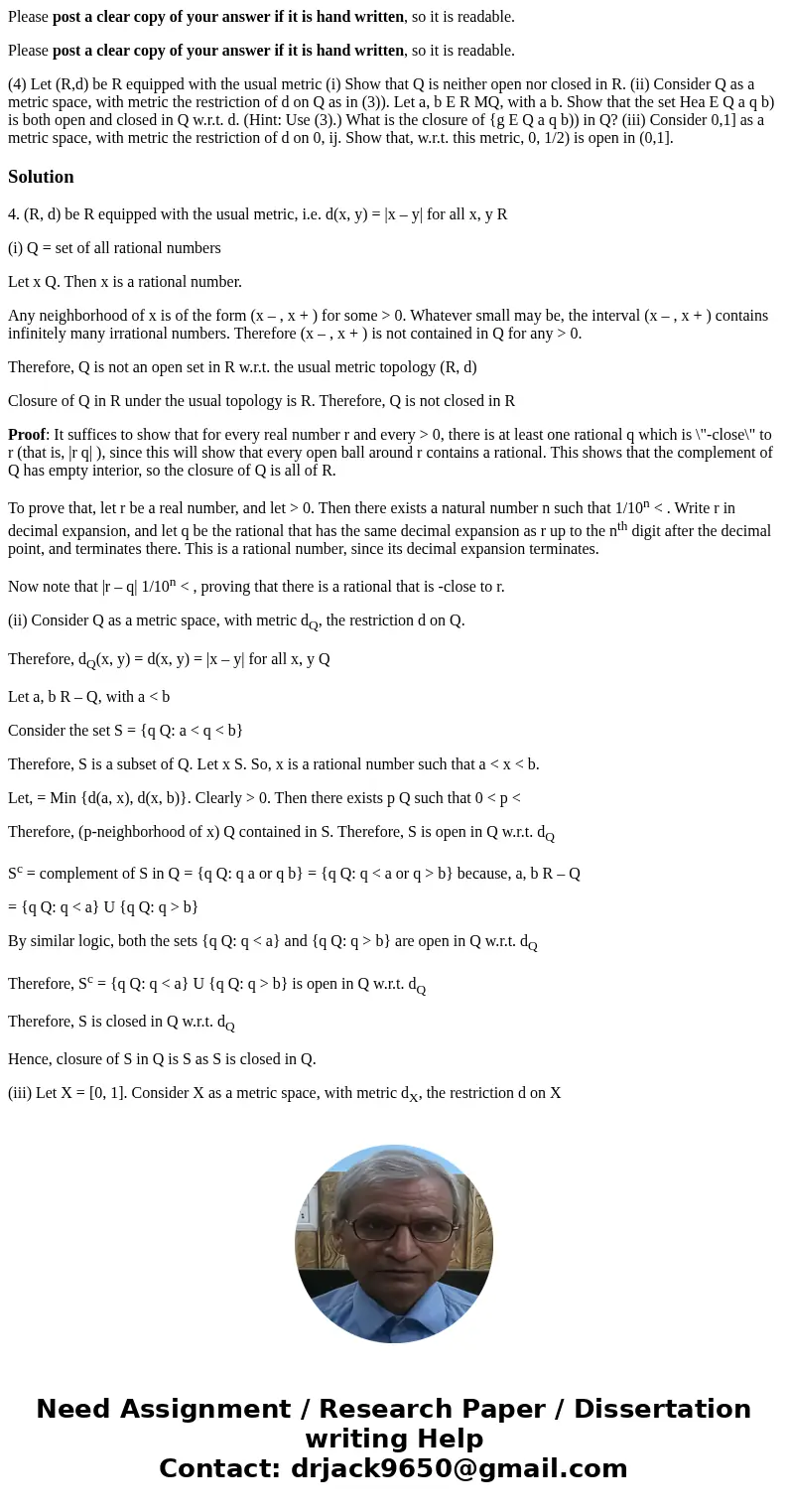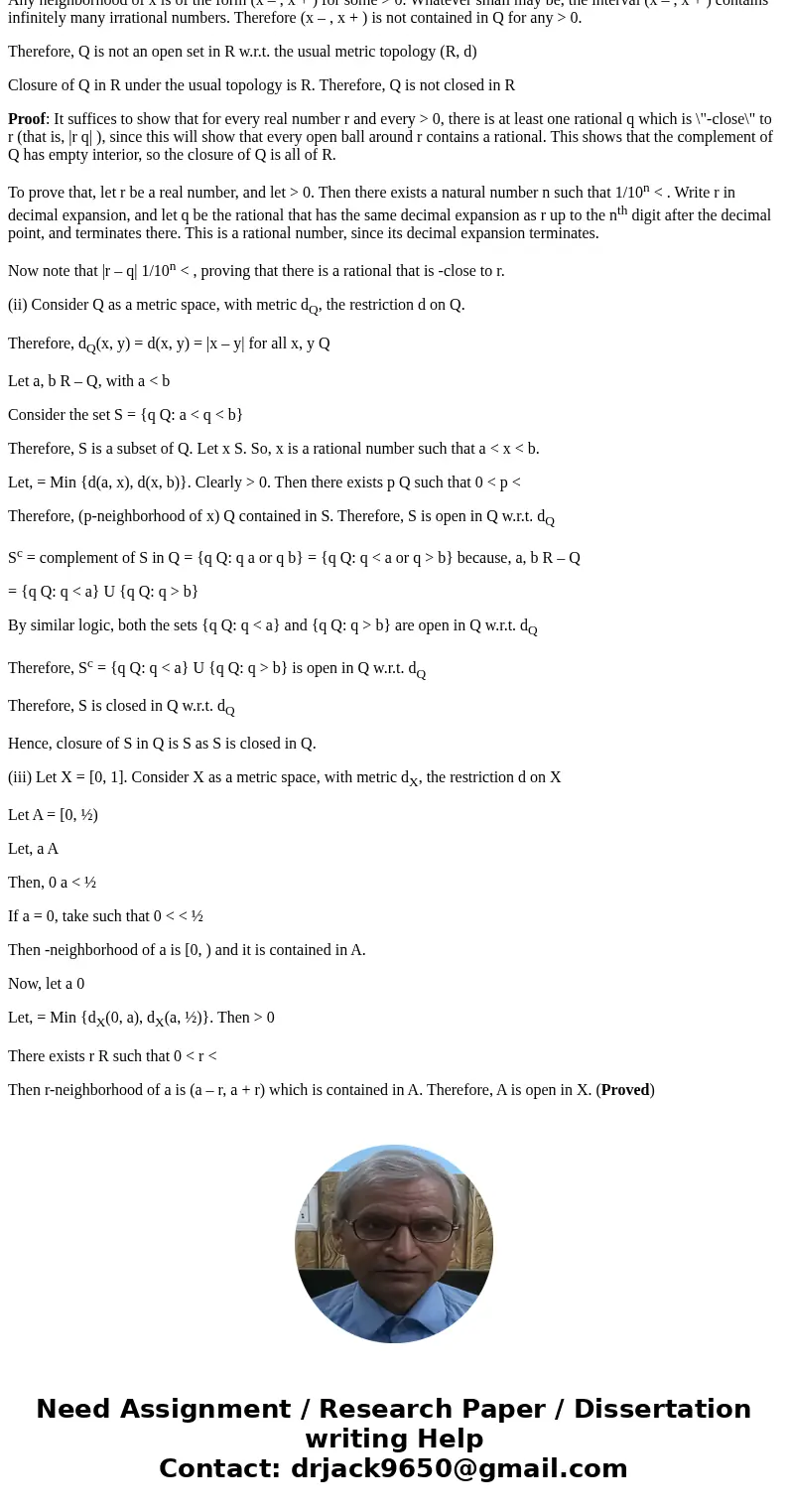Please post a clear copy of your answer if it is hand writte
Please post a clear copy of your answer if it is hand written, so it is readable.
Please post a clear copy of your answer if it is hand written, so it is readable.
(4) Let (R,d) be R equipped with the usual metric (i) Show that Q is neither open nor closed in R. (ii) Consider Q as a metric space, with metric the restriction of d on Q as in (3)). Let a, b E R MQ, with a b. Show that the set Hea E Q a q b) is both open and closed in Q w.r.t. d. (Hint: Use (3).) What is the closure of {g E Q a q b)) in Q? (iii) Consider 0,1] as a metric space, with metric the restriction of d on 0, ij. Show that, w.r.t. this metric, 0, 1/2) is open in (0,1].Solution
4. (R, d) be R equipped with the usual metric, i.e. d(x, y) = |x – y| for all x, y R
(i) Q = set of all rational numbers
Let x Q. Then x is a rational number.
Any neighborhood of x is of the form (x – , x + ) for some > 0. Whatever small may be, the interval (x – , x + ) contains infinitely many irrational numbers. Therefore (x – , x + ) is not contained in Q for any > 0.
Therefore, Q is not an open set in R w.r.t. the usual metric topology (R, d)
Closure of Q in R under the usual topology is R. Therefore, Q is not closed in R
Proof: It suffices to show that for every real number r and every > 0, there is at least one rational q which is \"-close\" to r (that is, |r q| ), since this will show that every open ball around r contains a rational. This shows that the complement of Q has empty interior, so the closure of Q is all of R.
To prove that, let r be a real number, and let > 0. Then there exists a natural number n such that 1/10n < . Write r in decimal expansion, and let q be the rational that has the same decimal expansion as r up to the nth digit after the decimal point, and terminates there. This is a rational number, since its decimal expansion terminates.
Now note that |r – q| 1/10n < , proving that there is a rational that is -close to r.
(ii) Consider Q as a metric space, with metric dQ, the restriction d on Q.
Therefore, dQ(x, y) = d(x, y) = |x – y| for all x, y Q
Let a, b R – Q, with a < b
Consider the set S = {q Q: a < q < b}
Therefore, S is a subset of Q. Let x S. So, x is a rational number such that a < x < b.
Let, = Min {d(a, x), d(x, b)}. Clearly > 0. Then there exists p Q such that 0 < p <
Therefore, (p-neighborhood of x) Q contained in S. Therefore, S is open in Q w.r.t. dQ
Sc = complement of S in Q = {q Q: q a or q b} = {q Q: q < a or q > b} because, a, b R – Q
= {q Q: q < a} U {q Q: q > b}
By similar logic, both the sets {q Q: q < a} and {q Q: q > b} are open in Q w.r.t. dQ
Therefore, Sc = {q Q: q < a} U {q Q: q > b} is open in Q w.r.t. dQ
Therefore, S is closed in Q w.r.t. dQ
Hence, closure of S in Q is S as S is closed in Q.
(iii) Let X = [0, 1]. Consider X as a metric space, with metric dX, the restriction d on X
Let A = [0, ½)
Let, a A
Then, 0 a < ½
If a = 0, take such that 0 < < ½
Then -neighborhood of a is [0, ) and it is contained in A.
Now, let a 0
Let, = Min {dX(0, a), dX(a, ½)}. Then > 0
There exists r R such that 0 < r <
Then r-neighborhood of a is (a – r, a + r) which is contained in A. Therefore, A is open in X. (Proved)


 Homework Sourse
Homework Sourse